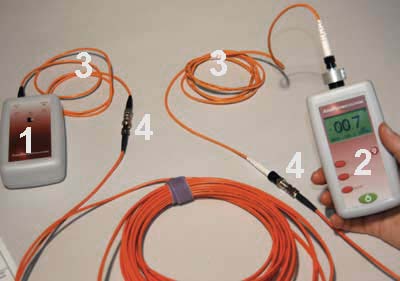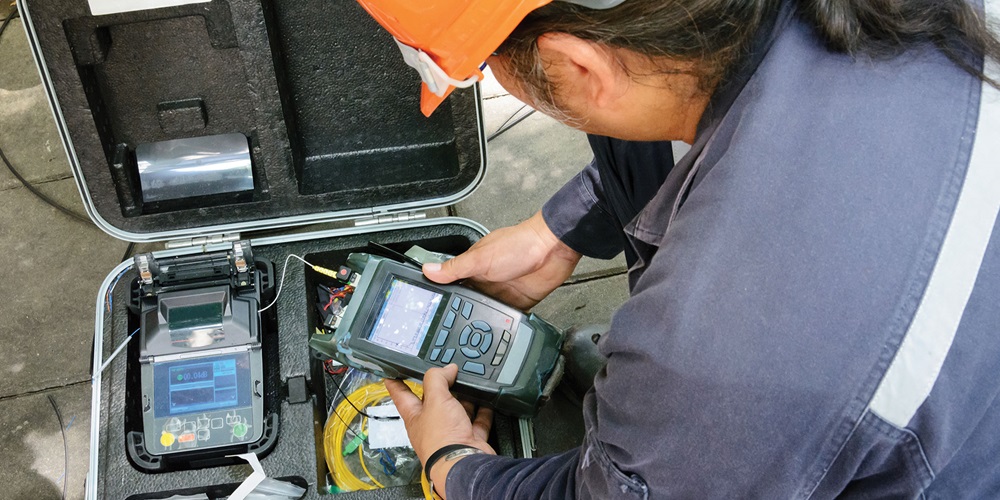Engineers work with the optical fibre diameter analyser to verify fibre uniformity.
Engineers work with the optical fibre diameter analyser to verify fibre uniformity.
Blog Article
Revealing the Trick Uses of Optical Fiber Examining for Efficient Data Transmission
In the realm of contemporary interaction, optical fibre testing arises as a necessary technique for maximizing information transmission. By utilizing methodologies such as Optical Time Domain Name Reflectometry (OTDR) and insertion loss evaluations, network drivers can efficiently determine and deal with issues that might endanger signal integrity. As the demand for faster and a lot more trustworthy connections remains to rise, the ramifications of these screening techniques expand past instant mistake detection, affecting long-lasting network efficiency. Recognizing the complex applications of optical fibre testing invites a much deeper exploration right into its essential duty in forming the future of data communication.

Value of Optical Fibre Testing
The importance of optical fiber testing can not be overstated, as it serves as a crucial component in ensuring the reliability and effectiveness of information transmission systems. In an era where high-speed interaction is vital, any kind of deficiencies in fiber optics can result in considerable information loss and reduced performance. As a result, extensive testing protocols are important to confirm the stability and efficiency of optical wires.
Evaluating permits the identification of issues such as micro-bends, macrobends, and splice losses that could prevent signal quality. Moreover, it supplies understandings into the overall depletion and data transfer capabilities of the fiber, making sure that the network satisfies particular functional criteria. Normal testing not just enhances system efficiency however also lengthens the life expectancy of the framework by determining prospective concerns before they intensify into expensive failings.

Kinds of Optical Fiber Tests
Numerous sorts of optical fibre tests are performed to make certain the performance and integrity of fibre optic networks. These examinations can be classified into numerous crucial types, each offering a particular function in examining the integrity of the fiber.
First, Optical Time Domain Name Reflectometry (OTDR) is a prominent examination that recognizes mistakes, splices, and adapters within the fiber. By sending pulses of light and assessing the shown signals, service technicians can determine concerns along the fibre's size.
2nd, insertion loss examinations review the quantity of signal loss when light go through ports or splices, which is essential for preserving network effectiveness.
Third, return loss examinations gauge the quantity of light showed back towards the source, offering insights right into the top quality of links and possible resources of disturbance.
Additionally, continuity examinations make sure that the fibre course is full, enabling service technicians to confirm that the fibre is undamaged without any breaks. fibre testing equipment.
Last but not least, visual fault locators utilize noticeable light to identify breaks or serious bends in the fibre, assisting in fast troubleshooting. Collectively, these tests create a thorough approach to keeping optimal efficiency in fiber optic networks.

Applications in Network Upkeep
In contemporary telecommunications, efficient network upkeep counts heavily on optical fibre testing to recognize and rectify problems promptly. Regular screening makes certain that the network operates at optimal performance levels, minimizing downtime and improving user experience.
One of the main applications of optical fibre testing in upkeep is the detection of faults, such as breaks, flexes, or incorrect connections. Methods like Optical Time Domain Name Reflectometry (OTDR) enable technicians to find these issues properly and analyze the high quality of the fibre web link. Furthermore, loss testing confirms the stability of the optical course, making sure that signal depletion remains within appropriate limits.
Routine maintenance screening likewise aids in preventative measures, determining potential troubles prior to they intensify into substantial failings. This aggressive strategy can save organizations both time and funds. Furthermore, throughout upgrades or growths, optical fibre testing makes sure that new installments integrate effortlessly with existing infrastructure.
Enhancing Information Transmission Integrity
Reliable network upkeep through optical fiber testing not only addresses immediate issues but also plays a substantial role in improving information transmission dependability. By recognizing faults, determining signal loss, and analyzing the general condition of fiber optic cords, testing ensures that potential issues are fixed before they rise into considerable interruptions.
Regular optical fiber testing, such as time-domain reflectometry (TDR) and optical time-domain reflectometry (OTDR), allows specialists to pinpoint the specific locations of breaks, flexes, or connector issues within the network. This aggressive approach not only minimizes downtime however likewise optimizes the performance of information transmission by ensuring that the paths for signals are clear and working efficiently.
In addition, screening aids in verifying adherence to you can look here sector standards and requirements, which is essential for maintaining the honesty of information circulation. By ensuring that each connection satisfies needed limits for loss and high quality, companies can bolster their confidence in the integrity of their information networks.
Eventually, investing in detailed optical fibre screening not only improves data transmission dependability but likewise supports the lasting functional performance of communication infrastructures.
Future Patterns in Fiber Testing
Emerging modern technologies are poised to transform fiber testing, paving the means for improved effectiveness and accuracy in data transmission diagnostics (optical fibre testing equipment). As the demand for faster internet and greater transmission capacity continues to climb, the integration of sophisticated tools such as synthetic knowledge (AI) and artificial intelligence (ML) is readied to transform typical fiber screening techniques. These technologies will allow predictive upkeep and automated mistake detection, substantially lowering downtime and boosting network reliability
Additionally, the fostering of Internet of Points (IoT) tools will certainly facilitate real-time surveillance of fiber networks, enabling for immediate identification of performance issues. This change towards proactive administration will certainly minimize interruptions and optimize data flow.
In addition, advancements in optical time-domain reflectometry (OTDR) and brand-new screening standards will enhance the accuracy of measurements, making sure that data stability is kept throughout the transmission process. The advent of 5G technology also necessitates the development of extra innovative fibre testing strategies to support its high-speed demands.
Conclusion
In conclusion, optical fibre testing is click this essential for preserving efficient information transmission within interaction networks. Routine screening not just ensures click for more info compliance with industry requirements but also promotes proactive upkeep, ultimately adding to the long-lasting dependability and efficiency of fiber optic systems.
Report this page